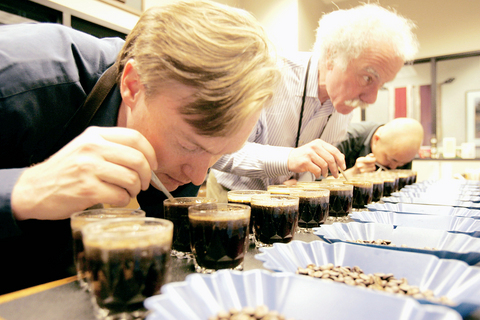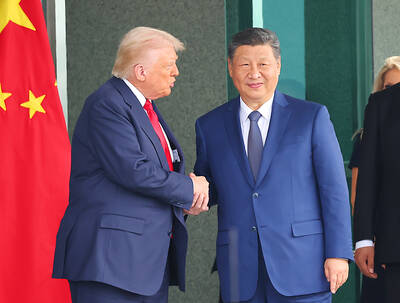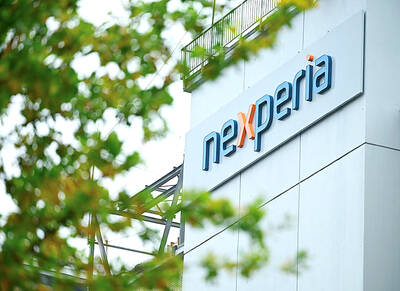Doug Welsh picked up the first of 12 glasses of coffee. He noisily slurped a spoonful, savored it briefly, then immediately spit it out.
Welsh, the vice president for coffee at Peet's Coffee and Tea, a regional coffee retailer with its home here in the San Francisco Bay Area, was "cupping" -- testing samples of beans recently shipped from the Nairobi coffee auction.
Welsh readily concedes that most customers would never know the difference. But buying what Peet's considers an inferior bean, he said, "is not a road we want to go down."

PHOTO: NY TIMES15
In the Bay Area, Peet's has long been the Apple Computer of coffee, serving a small but intense group of aficionados who are convinced that the company's coffee is superior to that produced by the industry giant from Seattle: Starbucks.
Now Peet's, which also sells over the Internet and by mail order, has significantly stepped up its expansion plans. It is opening more retail stores in the west and introducing its brand to a number of specialty and high-end grocery stores across the US, hoping to entice a growing group of coffee iconoclasts.
"Peet's grew out of a passion for specialty coffee," said Kerri Goodman-Small, publisher of Hospitality News, a food service industry journal. "Starbucks focuses on consistency and a variety of beverages."
For all their differences in size and style, Peet's and Starbucks are linked by their past: the current director of Peet's, Gerald Baldwin, co-founded Starbucks before selling out to Howard Schultz, who built it into the ubiquitous brand of today.
Operating in Starbucks' very large shadow, Peet's is one of several small gourmet coffee retailers that are expanding from strong regional bases. These include Caribou Coffee from Minneapolis; Diedrich Coffee, based in Irvine, California; It's a Grind from Long Beach, California, and Tully's Coffee, with headquarters in Seattle.
The passion for Peet's extends to Ruth Reichl, the editor in chief of Gourmet magazine. "You only had to taste it once to see that, `Oh, this is coffee,'" said Reichl, who grew up in Berkeley but now lives in New York. Her old friends, she said, still bring her bags of Peet's whenever they visit from California.
Operating out of a brick warehouse in this industrial area south of Berkeley, Peet's is a debt-free company that has managed to achieve a steady rise in sales since it went public in 2001. This last quarter, revenue grew 23 percent from a year earlier, to $40 million, while earnings rose 34 percent, to US$2.4 million. In a stagnant market, its stock is up 3.3 percent since the beginning of the year. It closed Friday at US$29.80, up US$0.02 cents.
By comparison, revenue for Starbucks for the quarter ended in April reached US$1.5 billion, up 22 percent from the year-earlier period. Its net earnings for the period increased 27 percent, to US$101 million.
While Peet's has accelerated the opening of its retail stores, the company's business is built around selling beans, not drinks. Sales of whole beans account for 45 percent of Peet's retail revenue, compared with 5 percent at Starbucks.
Peet's retail stores, said Patrick J. O'Dea, the company's president, are "a fresh market for whole beans that happens to sell beverages."
"When our stores are strong," O'Dea said, "our Internet, mail order and grocery businesses go up within a five-mile radius of the outlet. We're agnostic about where people buy our product. Retailing is a means to an end, not the end in itself."
Starbucks takes a different approach. Its retail stores were responsible for 85 percent of the company's revenue in the most recent six-month period. Retail operations are "the primary driver of the company's revenue growth," its latest financial report notes.
Compared with Starbucks' 6,605 stores in the United States and an additional 2,656 abroad, the Peet's operation is about as noticeable as a fly on an elephant. Peet's operates just 99 outlets, up from 75 at the beginning of last year. It expects to open another 20 this year.
The company plays on its 1960s image, highlighting its Berkeley coffee house roots and filling 2,000 higher-margin mail orders a day to its nationwide roster of committed "Peetniks" buyers.
"The key is Peet's can complement Starbucks," said Matthew Difrisco, who has advised the company for Thomas Weisel Partners, a San Francisco venture capital firm that helped Peet's raise money after it went public. "The Peet's customer is older, more mature and better educated."
Peet's continues to thrive by attracting consumers like Jenna Phillips, a Berkeley clothing designer who says she is "a total Peet's devotee."
The coffee is "stronger than Starbucks'," she said, "and it's not part of an evil empire."
Peet's retail stores, in a more subtle dig at Starbucks, reflect what it considers an all-American style. Rather than call its different cup sizes "grande" and "venti," for example, it displays simply "small," "medium" and "large" on its in-store menu.
"If we were going to establish our own retail culture," said Baldwin, Peet's director, "we had to stop speaking Italian."
The company began operations in Berkeley in 1966, when Alfred Peet, a Dutch immigrant, opened his first store. A few years later, Baldwin and two partners opened their own coffee shop in Seattle, and contracted with Peet to supply their store with beans.
They called their store Starbucks, and gradually expanded it to five stores. In 1984, the Starbucks threesome bought the small Peet's chain. Three years later, believing that Peet's epitomized their zeal for coffee, they sold Starbucks to Howard Schultz.
O'Dea says Peet's has not compromised quality, despite its accelerated growth.
Coffee is still roasted manually, and all coffee is shipped the same day it is roasted. The company maintains its own fleet of grocery store delivery trucks. Whole coffee at Peet's retail outlets is discarded after 10 days and brewed coffee is thrown out after 30 minutes.
Starbucks says it follows equally rigorous standards. "Freshness and quality are one and the same," said Dub Hay, Starbucks' senior vice president for coffee and global procurement.
Starbucks has long-standing relationships with coffee growers around the world, and recently opened a coffee farmers' support center in Costa Rica.
To ensure freshness, Hay said, Starbucks sells only prepackaged whole bean coffee in its retail stores, and discards unsold brewed coffee after one hour.
Peet's expects to benefit from the growing taste for small affordable luxuries. As long as growth does not reduce the appeal of its coffees and teas, Baldwin predicted that Peet's would remain successful.
"When Starbucks came to San Francisco, the press was filled with stories about how Peet's will get killed," he said. "We're fine."

RUN IT BACK: A succesful first project working with hyperscalers to design chips encouraged MediaTek to start a second project, aiming to hit stride in 2028 MediaTek Inc (聯發科), the world’s biggest smartphone chip supplier, yesterday said it is engaging a second hyperscaler to help design artificial intelligence (AI) accelerators used in data centers following a similar project expected to generate revenue streams soon. The first AI accelerator project is to bring in US$1 billion revenue next year and several billion US dollars more in 2027, MediaTek chief executive officer Rick Tsai (蔡力行) told a virtual investor conference yesterday. The second AI accelerator project is expected to contribute to revenue beginning in 2028, Tsai said. MediaTek yesterday raised its revenue forecast for the global AI accelerator used

TEMPORARY TRUCE: China has made concessions to ease rare earth trade controls, among others, while Washington holds fire on a 100% tariff on all Chinese goods China is effectively suspending implementation of additional export controls on rare earth metals and terminating investigations targeting US companies in the semiconductor supply chain, the White House announced. The White House on Saturday issued a fact sheet outlining some details of the trade pact agreed to earlier in the week by US President Donald Trump and Chinese President Xi Jinping (習近平) that aimed to ease tensions between the world’s two largest economies. Under the deal, China is to issue general licenses valid for exports of rare earths, gallium, germanium, antimony and graphite “for the benefit of US end users and their suppliers

Dutch chipmaker Nexperia BV’s China unit yesterday said that it had established sufficient inventories of finished goods and works-in-progress, and that its supply chain remained secure and stable after its parent halted wafer supplies. The Dutch company suspended supplies of wafers to its Chinese assembly plant a week ago, calling it “a direct consequence of the local management’s recent failure to comply with the agreed contractual payment terms,” Reuters reported on Friday last week. Its China unit called Nexperia’s suspension “unilateral” and “extremely irresponsible,” adding that the Dutch parent’s claim about contractual payment was “misleading and highly deceptive,” according to a statement

Artificial intelligence (AI) giant Nvidia Corp’s most advanced chips would be reserved for US companies and kept out of China and other countries, US President Donald Trump said. During an interview that aired on Sunday on CBS’ 60 Minutes program and in comments to reporters aboard Air Force One, Trump said only US customers should have access to the top-end Blackwell chips offered by Nvidia, the world’s most valuable company by market capitalization. “The most advanced, we will not let anybody have them other than the United States,” he told CBS, echoing remarks made earlier to reporters as he returned to Washington